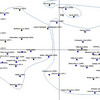Comprehensive
According to the authors, they did “a systematic literature search and co-citation analysis to investigate the specific research domains of organizational resilience and its strategic and operational management to understand the current state of development and future research directions”. More than 400 papers out of thousands of documents were selected and narrowed down to 70 or so core papers, clearly showing the dominating trends within research into organisational resilience.
1.Theoretical foundations and applications, e.g. Christopher and Peck (2004)
2. Implementation, improvement and measurement of resilience, e.g. Sheffi and Rice (2005)
3. Models for resilience.
4. Other theoretical perspectives.
(The linked papers have been reviewed on this blog)
What to read, or not
In addition, the authors used multidimensional scaling(MDS) to produce a graphic that represents conceptual proximity, or similarity, between publications. This is what I found to be the most interesting part about this paper, because I now can find the most related or otherwise different literature, just by looking at the figure below and going to the reference list in the paper. That is very helpful, indeed.
It’s quite interesting to see where some of the papers that have been reviewed on this blog fall and what papers that are closely related and that I have not yet discovered, which means that I have a lot of work to do in terms of possible reviews on this blog.
Future research
Finally the authors describe 7 areas of future research
Theory testing on design, implementation, and improvement processes to enhance organizational resilience.
Measurement of organizationalandoperationalresilience.
Resilience in Small Medium Enterprises.
Restoration models for the supply chain and operational processes.
Impact of introducing information systems on organizational resilience.
Anticipatory innovation to enhance processes’ resilience.
Strategic approach and dynamic capabilities for becoming a resilient organization.
and why these are the important issues that warrant further investigation.
Conclusion
This paper’s reference list contains more than 200 items. Combined with the sorting and review done in the paper this is very valuable resource for any researcher of organisational resilience.
Reference
Annarelli, A., & Nonino, F. (2015). Strategic and operational management of organizational resilience: Current state of research and future directions Omega DOI: 10.1016/j.omega.2015.08.004
Author links
- linkedin.com: Alessandro Annarelli
- linkedin.com: Fabio Nonino
Related posts
- husdal.com: The resilient organization
